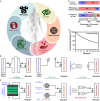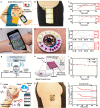Wearable devices for continuous monitoring of biosignals: Challenges and opportunities
- PMID: 35464617
- PMCID: PMC9010050
- DOI: 10.1063/5.0086935
Wearable devices for continuous monitoring of biosignals: Challenges and opportunities
Abstract
The ability for wearable devices to collect high-fidelity biosignals continuously over weeks and months at a time has become an increasingly sought-after characteristic to provide advanced diagnostic and therapeutic capabilities. Wearable devices for this purpose face a multitude of challenges such as formfactors with long-term user acceptance and power supplies that enable continuous operation without requiring extensive user interaction. This review summarizes design considerations associated with these attributes and summarizes recent advances toward continuous operation with high-fidelity biosignal recording abilities. The review also provides insight into systematic barriers for these device archetypes and outlines most promising technological approaches to expand capabilities. We conclude with a summary of current developments of hardware and approaches for embedded artificial intelligence in this wearable device class, which is pivotal for next generation autonomous diagnostic, therapeutic, and assistive health tools.
© 2022 Author(s).
Figures






References
-
- Castillejo P., Martinez J.-F., Rodriguez-Molina J., and Cuerva A., “ Integration of wearable devices in a wireless sensor network for an E-health application,” IEEE Wireless Commun. 20, 38–49 (2013).10.1109/MWC.2013.6590049 - DOI
-
- Billinghurst M. and Starner T., “ Wearable devices: New ways to manage information,” Computer 32, 57–64 (1999).10.1109/2.738305 - DOI
Publication types
LinkOut - more resources
Full Text Sources

